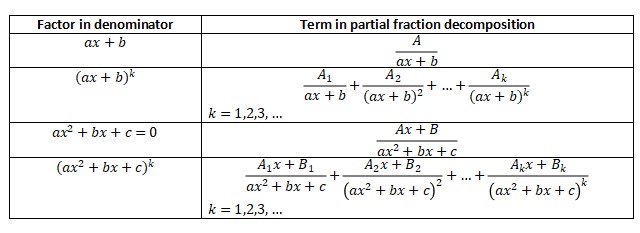Table of Contents
What are partial fractions?
Fraction form can’t be ignored in mathematics. Some theorem or topics in mathematics using fraction and also partial fraction.
The fractions are possible to be split into two or more simple fraction and it is called partial fraction.
Partial fraction is one of ways to calculate complex fraction to be easier. It is changed to be partial fraction first.
Partial fraction is also identic with polynomial. So, before calculating partial fraction, polynomial concept must be studied.
Partial fraction decomposition
Partial fraction decomposition means a process to “decompose” or start to simplify a fraction and taking it back apart. To decompose a fraction, first step is factoring the denominator.
As illustration, look at the fraction below.

The fractions are simple fraction because it consists of two terms, but it can be more complex fraction if it is one term.
It will be

Now, how if the case is complex fraction?
Changing complex fraction to be partial fraction is the solution. One important thing in partial fraction is the degree of numerator is always less than the denominator.
There are steps to make partial fraction easily:
- Express it to be two terms with each denominator
- Look at the nominator. Multiply through by the bottom
- Find the constant by substituting the roots of the bottom
There many forms in denominator. Lok at the table. It shows the factor of denominator and the term in partial fraction

Examples
1. Express to be partial fraction

Answer:
- Express it to be two terms with each denominator

- Look at the nominator. Multiply through by the bottom
x + 5 = a(x + 1) + b(x – 3)
- Find the constant by substituting the roots of the bottom
First root
x – 3 = 0 → x = 3
Then
3 + 5 = a(3 + 1) + b(3 – 3)
8 = 4a
a = 2
Second root
x + 1 = 0 → x = -1
Then
(-1) + 5 = a(-1 + 1) + b(-1 – 3)
4 = -4b
b = -1
So, the answer is

2. Express in partial fraction

Answer:
Using step by steps
- Express it to be two terms with each denominator

- Look at the nominator. Multiply through by the bottom
17x – 1 = a(x – 3) + b(3x + 1)
- Find the constant by substituting the roots of the bottom
First root
x – 3 = 0 → x = 3
Then
17(3) – 1 = a(3 – 3) + b(3(3) + 1)
50 = 10b
b = 5
Second root
3x + 1 = 0 → x = -⅓
Then
17(-⅓) – 1 = a((-⅓) – 3) + b(3(-⅓) + 1)
a = 2
So, the answer is

3. Express in partial fraction

Answer:
This case is little different with previous examples. Based on the table (second row), it will be

Look at the nominator. Multiply through by the bottom
x2 + 1 = Ax((x – 1)2) + Bx(x – 1) + Cx + D((x – 1)3)
Find the constant by substituting the roots of the bottom
First root x = 0 then
02 + 1 = A.0((0 – 1)2) + B.0(0 – 1) + C.0 + D((0 – 1)3)
D = -1
Second root x = 1 then
12 + 1 = A.1((1 – 1)2) + B.1(1 – 1) + C.1 + D((1 – 1)3)
C = 2
Then, how about A and B?
Pick any two other x-values, plug in, and get a system of equations so that A and B can be solved.
For example, x = 2 then
22 + 1 = A.2((2 – 1)2) + B.2(2 – 1) + C.2 + D((2 – 1)3)
A + B = 1
Another x = -1, then
(-1)2 + 1 = A.(-1)(((-1) – 1)2) + B.(-1)((-1) – 1) + C.(-1) + D(((-1) – 1)3)
2A – B = 2
Next, using the both of equation A dan B, eliminated them and will be get A = 1 and B = 0.
So, the answer is

